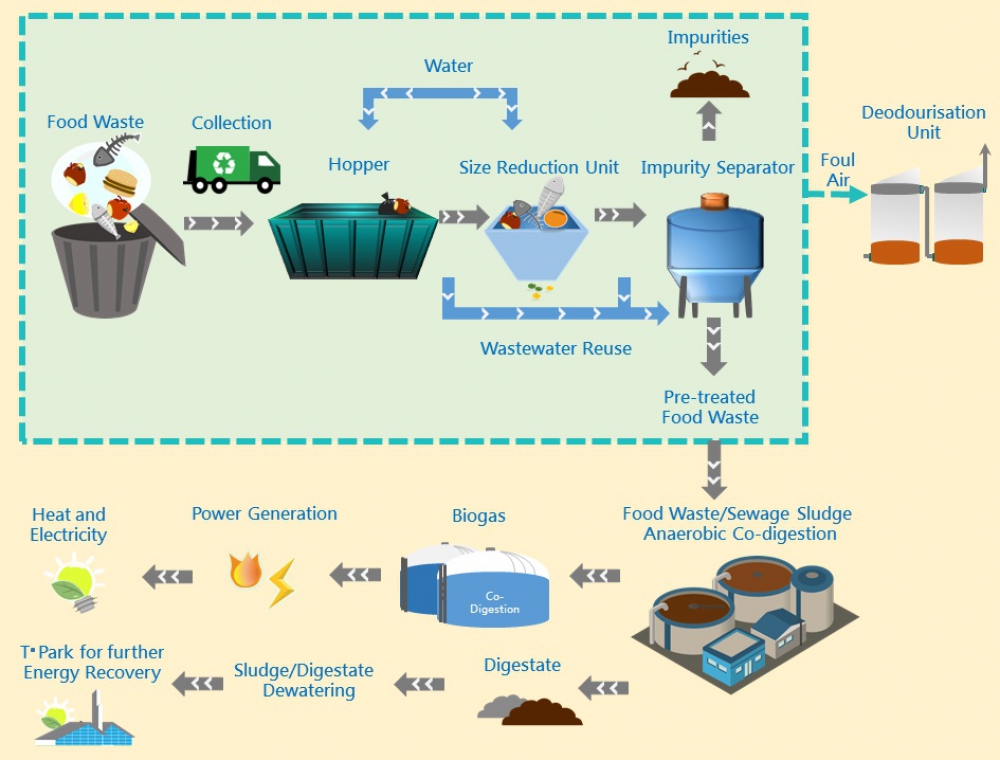Implemented Measures for Saving Energy and Harnessing Renewable Energy
At present, RE installations in DSD's plants generate over 28 million kilowatt-hours of electricity per annum, constituting around 9% of DSD's annual energy demand. In terms of efficiency, DSD's current annual RE contribution is equivalent to the energy consumption of 5,600 households and can reduce about 19,600 tonnes of carbon dioxide (CO2) emission a year.
In addition, DSD obtained a capital funding of $248 million in total for 12 major renewable energy projects in 2017–18 and 2018–19 to generate a total of 6 million kilowatt-hours of electricity a year. These projects are under construction. Besides, DSD has been optimising the operation of various sewage treatment works (STWs) and sewage pumping stations (SPSs), including replacement of ageing equipment with more efficient energy saving units. The items being replaced include the plants' air blowers, lighting systems, pumps, and screens. With these RE projects and energy saving initiatives, DSD has set an electricity saving target of 4% by 2024-25, with respect to the baseline electricity consumption of about 315 million kilowatt-hours in 2018-19. DSD is striving to achieve this target.
Solar Energy – Installation of Photovoltaic Panels in Sewage Treatment Facilities
Over the years, DSD has endeavoured to utilise the open space in STWs and SPSs to install photovoltaic (PV) system. As at end March 2019, DSD has installed PV panels at 15 STWs and 13 SPSs to harness solar energy by maximising the use of the plants' space. The major plants include Sha Tin STW, Yuen Long STW, Shek Wu Hui STW and Stonecutters Island STW. Notably, the Solar Farm at Siu Ho Wan STW commissioned at the end of 2016, comprises over 4,200 units of polycrystalline PV panels which can generate as much as 1.1 million kilowatt-hours of electricity annual, making it the largest PV system among the Hong Kong SAR Government facilities at present. In 2018-19, the total PV system of DSD is generating about 1.12 million kilowatt-hours of electricity.
DSD will continue to extend the use of solar power in its facilities and install more PV panels at various pumping stations and STWs. The total generation capacity of the new systems is about 0.9 megawatts, including the installation of thin-film PV panels above the sedimentation tanks at Stonecutters Island STW, fully utilising space to generate energy. It will become the largest thin-film solar system in Hong Kong, with a generation capacity of over 0.5 megawatts.
PV Installations at Sha Tin Sewage Treatment Works
Hydroelectric Power– Hydro-turbine System at Stonecutters Island Sewage Treatment Works
After the commission of the Harbour Area Treatment Scheme Stage 2A, DSD installed a hydro-turbine system which utilises hydraulic energy from the flow of sewage to move the turbine and generate electricity for inhouse use at Stonecutters Island STW. It is a completely automated operation, regulating the generator speed according to the daily sewage flow rate in order to enhance its operating efficiency. The system commissioned in October 2018, with a design capacity of 23 kilowatts, it is expected to generate up to 120,000 kilowatt-hours of electricity a year. The system does not only save electricity costs, but also make good use of hydropower to reduce carbon emissions. In light of the high efficiency of this project, we plan on installing a second hydroturbine system at Stonecutters Island STW.
Hydro-turbine system at Stonecutters Island Sewage Treatment Works
Waste to Energy
Sludge, a byproduct of sewage treatment process, produces biogas during anaerobic digestion. Biogas is a form of renewable energy which contains 65% methane (the remaining components mainly being carbon dioxide). DSD utilises combined heat and power (CHP) generators and gas-turbines that run on biogas to generate electricity and heat for in-house use. In 2018-19, the total electricity generation capacity of five CHP generators at Sha Tin STW, Tai Po STW and Shek Wu Hui STW is about 3.6 megawatts, while two gas-turbines at Sha Tin STW and Yuen Long STW have a total electrical generating capacity of 280 kilowatts. This year, the total energy generated by biogas at our STWs amounted to about 27 million kilowatt-hours.
A 30 kilowatt micro-turbine generator at Yuen Long Sewage Treatment Works
A 1.4-megawatt combined heat and power generator at Sha Tin Sewage Treatment Works
A new biogas-fueled combined heat and power generator at Sha Tin Sewage Treatment Works
To maximise the use of biogas generated during the sludge treatment process, we are installing additional CHP generators and gas-turbine systems at our STWs such as Sha Tin STW, Tai Po STW and Yuen Long STW. Once completed, it is anticipated that up to 5.4 megawatts of electricity can be generated. In addition, a tri-generation system, which generates heat, cooling and power has been installed at Sha Tin STW to increase the use of RE.









